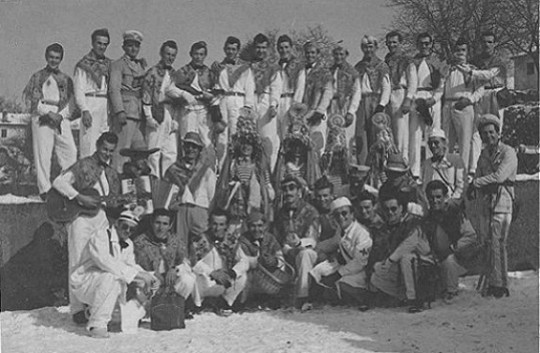 |
|
Žejanski
Zvonćari, 1956
(Courtesy of
Antony Sankovic - guitarist, middle row left) |
Folk Histria - In Search of its Identity
[Žejane's
Shrovetide]
Carnival Festivities are part of Žejane's
rich tradition.
Žejane
(Seiane) is a small village in the hinterland of
Rijeka (Fiume) and
Opatija (Abbazia) in the foothills of the
Ćićarija
(Ciceria) mountain
massif along the road which connects that region with northwestern
Istria. The name of the village was mentioned for the first time in the
14th century. Today
Žejane has a unique distinction in the region
because we have saved the
Žejane's language (Istro-Romanian) originally
spoken by the inhabitants who settled in this region in the 16th century
while escaping the Turkish invasions..
Carnival Festivities begins in
Žejane on
the Adoration of the Magi (Epiphany), when the first Carnival bells ring
to signal the beginning of the "Mesopust" or "Pust," also known as
Shrovetide. The most important part of this tradition are "Zvončari"
(The Bell Bearers). These Zvončari are different from other Bell bearer
groups because of their equipment and their dress, as well as of the
harmonious tolling of their bells which are very pleasant to one's
ears.
Let us describe their dress. They wear
white trousers and sailor`s undershirt or sleeveless shirts. An
indispensable part of their equipment are the "šuba" (sheepskin) and the
three bells called "klopote" in the Žejane language. The Bell Bearers
wear the bells on their hips (one on each side and one on the back tied
together with a rope). On their heads they have a "kumarak" (hat) which
is decorated by "bajera" (paper ribbons of various colours). The ribbons
stretch down to their feet. The top of the hat is ornamented by flowers
and small paintings adorned with love motifs. Every Bell Bearer has in
his hand a wooden stick with a "boća" (a type of ball) on the top.
At the time of carnival, Zvoncari call
upon the neighbouring villages and the houses in
Žejane. By that gesture
they symbolize fertility and coming of spring after long and severe
winter.
Today people (young and old) of Žejane
form the Last Day of Shrovetide Group, called "Žejanski-Žvoncari" (The
Bell Bearers of Žejane). A folk group is also included in this group in
addition to a musical group which practices "bugarenje", a two-voice
harmony singing in the Žejane language. In addtion to the costumes of
the Bell Bearers, there is the "Počrnjenka", the richly decorated
peasant costume representative of authentic wealth. Historically,
daughters of richer families wore this garment only during holidays and
festivities or celebration.
|
 |
|
Bell Ringers at 2004 Carneval |
|
In this way
Žejane continues the
tradition and authenticity of the Bell Bearers along with their visits
to the neighboring villages. These customs and traditions are preserved
and most importantly are being forwared to our young people for future
generations..
Mauro Doricic (edited by
Denis Sankovic)
Žejane 84A
Žejane 51212
Croatia
Tel. 734-117
Source:
-
July 13, 1999, © 1999 Glas Istre, courtesy of Denis Sankovic
-
Color photograph - https://www.lovran.com/events/carnival2004.html -
Carneval 2004
Related links:
-
Denis Sankovic music collection (includes samples of music of
Žejane and Žejanski-Zvoncari).
-
https://www.opatija.hr/karneval/index_e.htm - Karneval u Opatiji
(Hrvatski) - https://www.opatija.hr/karneval/index_e.htm - Carnival
in Opatija (English), includes a sample of Zvoncari music
Other links:
-
https://top.pefri.hr/seminari/zvoncari/nasl_str.html - Zvoncarima
(Hrvatski)
-
https://www.sigov.si/ueilbi/skoromat/ - Škoromati, Podgrad - Celebration
of Shrovetide in Slovenian istria (in Slovenian and English)
|
Today people (young and old) of Žejane
form the Last Day of Shrovetide Group, called "Žejanski-Žvoncari" (The
Bell Bearers of Žejane). A folk group is also included in this group in
addition to a musical group which practices "bugarenje", a two-voice
harmony singing in the Žejane language. In addtion to the costumes of
the Bell Bearers, there is the "Počrnjenka", the richly decorated
peasant costume representative of authentic wealth. Historically,
daughters of richer families wore this garment only during holidays and
festivities or celebration.
Main
Menu
This page compliments of
Mario Demetlica and Denis Sankovic
Created:Thursday, August
19, 1999; Last updated:
Sunday, December 11, 2022
Copyright
© 1998
IstriaNet.org, USA |